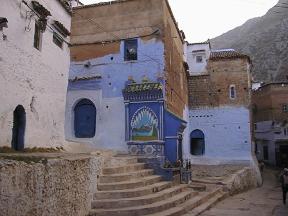
Chefchaouen
September 2nd - September 4th, 1999

All the tour books rave about the little mountainside town of Chefchaouen, saying it's a favorite of travelers as a respite from the oppressive Moroccan heat. Founded in 1471 as a base to attack the Portuguese in the north, Chefchaouen really grew in the late 15th century with the arrival of refugees from the newly christianized Spain. They brought a certain Spanish influence, most notably the white-washed and trademark blue-washed houses.

We found a hotel in the medina and found it easy to navigate without getting horribly lost. While Chefchaouen is cooler than much of the rest of Morocco, it wasn't quite the refreshing retreat we hoped it would be. Days would notably warm up, and most of the restaurants were pretty bad. We feel that what makes Chefchaouen such a traveler favorite is the extremely cheap accommodations and the readily available hashish, which one smells frequently as you wander around the medina.
Chefchaouen is a quick trip as a tourist sight, with the main attractions right off the central square. These include the 17th century Kasbah built by that rascal Moulay Ismail, which now houses a nice garden and crafts museum, and the 15th century grand mosque with its unusual eight sided minaret. Perhaps more interesting are the numerous artisan and craft houses peppered through the city. We were pretty burned out on carpets and tanneries, so we spurned offers to visit them, but we did come across a wonderful artist community just off the Hôtel Parador's parking lot that built beautiful Moroccan style bird cages -- something we hadn't seen in all our travels through the country (no photos - sorry).
|
|
If you like to hike, you've come to the right place. We took a nice morning hike up the shoulders of the mountain to visit the ruins of an ancient mosque overlooking the city. We found that we couldn't enter the old mosque's tower, as a family of sheep were huddled on the stairway escaping the morning's heat; wonder what the old mosque's preachers would say about that? In the city shot on the bottom left, you can see the muslim graveyard we walked through. That day was Friday, the muslim sabbath, and several people were visiting graves of departed loved ones, some singing beautiful, mournful songs.
|
|
|
One of the noticeable difference now that the King's mourning period is over is the number of weddings that are going on here. No fests were allowed during the mourning, and that pretty much put the muzzle on the marriage parties. Each night in Chefchaouen was marked with huge parties and the following day we would see bridal parties heading up toward the mosque near our hotel. And, boy, do they make lots of noise!
One of the noisiest Moroccan instruments took us quite by surprise. Somehow, someway, the bagpipe migrated to this land and has been accepted as a traditional instrument! Perhaps it's the Spanish influence that pervades Chefchaouen that allowed the Galician bagpipe to migrate here, but bagpipes are used here, oftentimes in marriage celebrations.
Moroccan Snacks
On the way to our next destination, our bus stopped in a little flyspeck town that offered us a photo opportunity we couldn't pass up. We had seen many snack shops like this, but never bothered to linger or take a photo. These snack shops hang their carcasses of meat out in the open, flies and all, and if you see something you like they'll hack it off and grill it for you right on the spot. The meat isn't salted, cured or smoked, and it hangs out all day, day after day, until it's gone. No wonder so many people are sick here with food handling like that.
